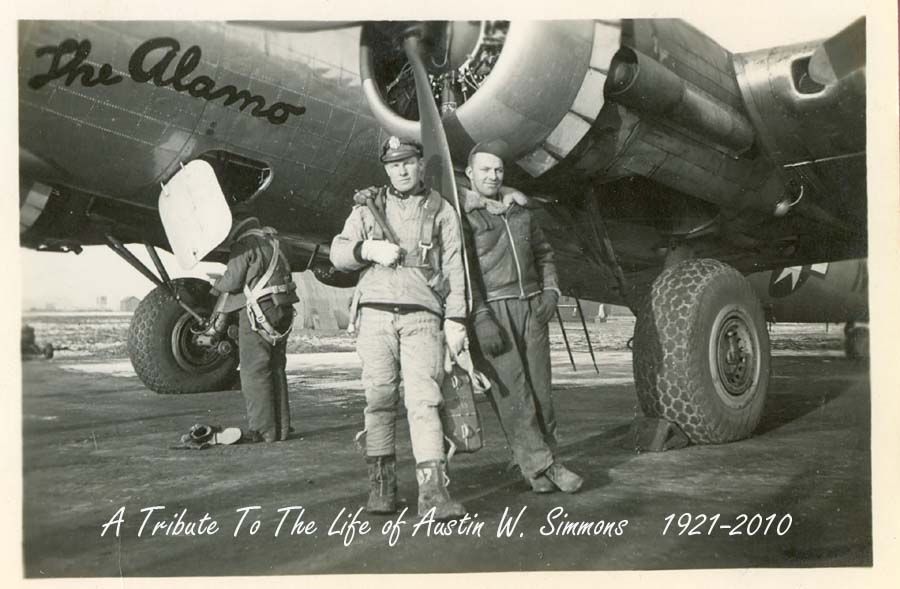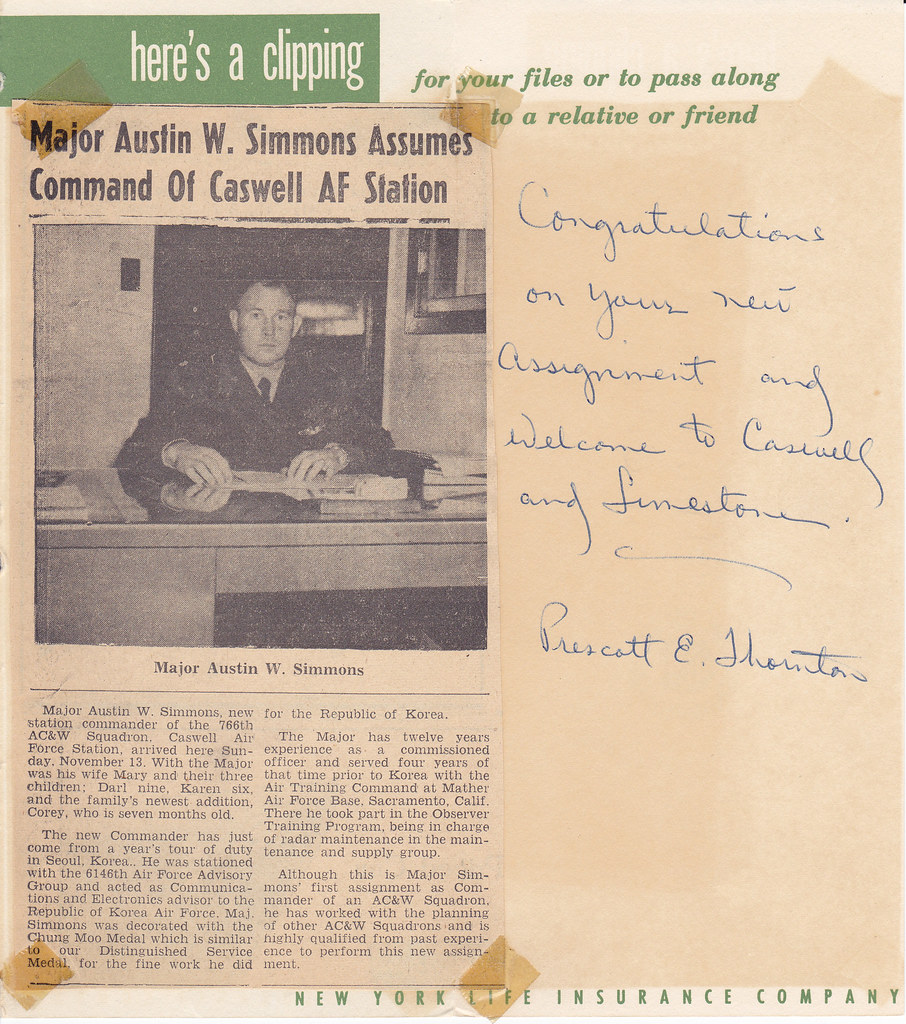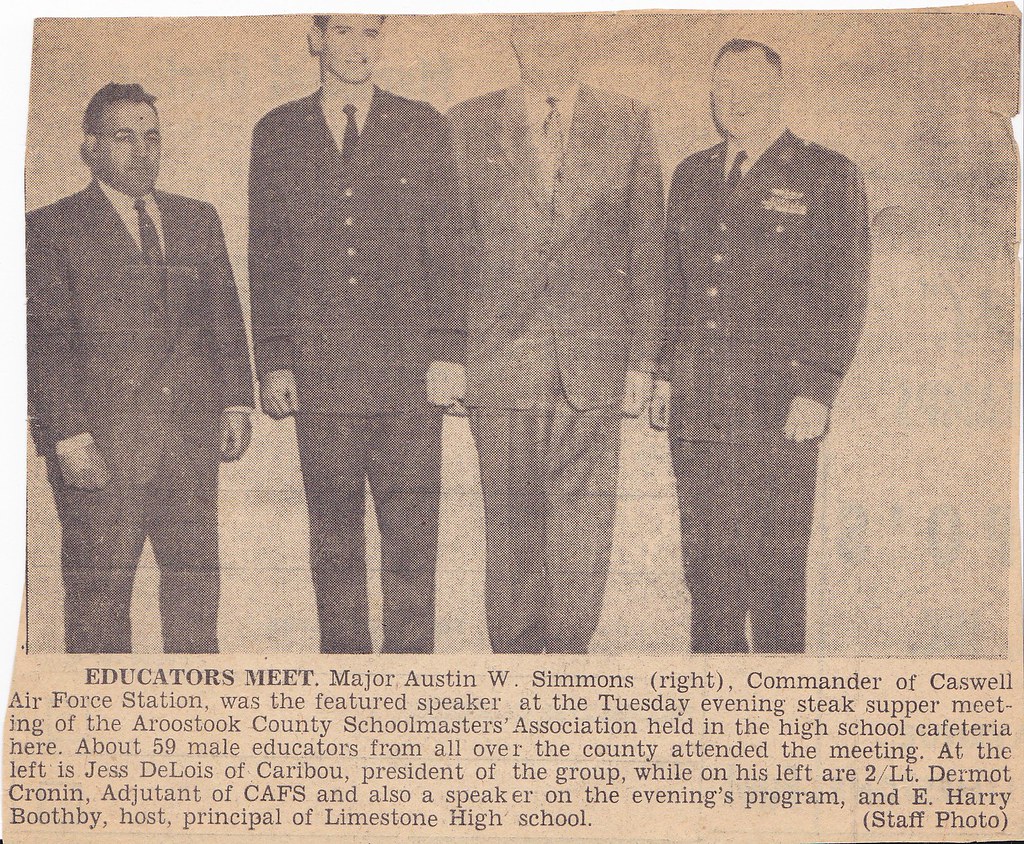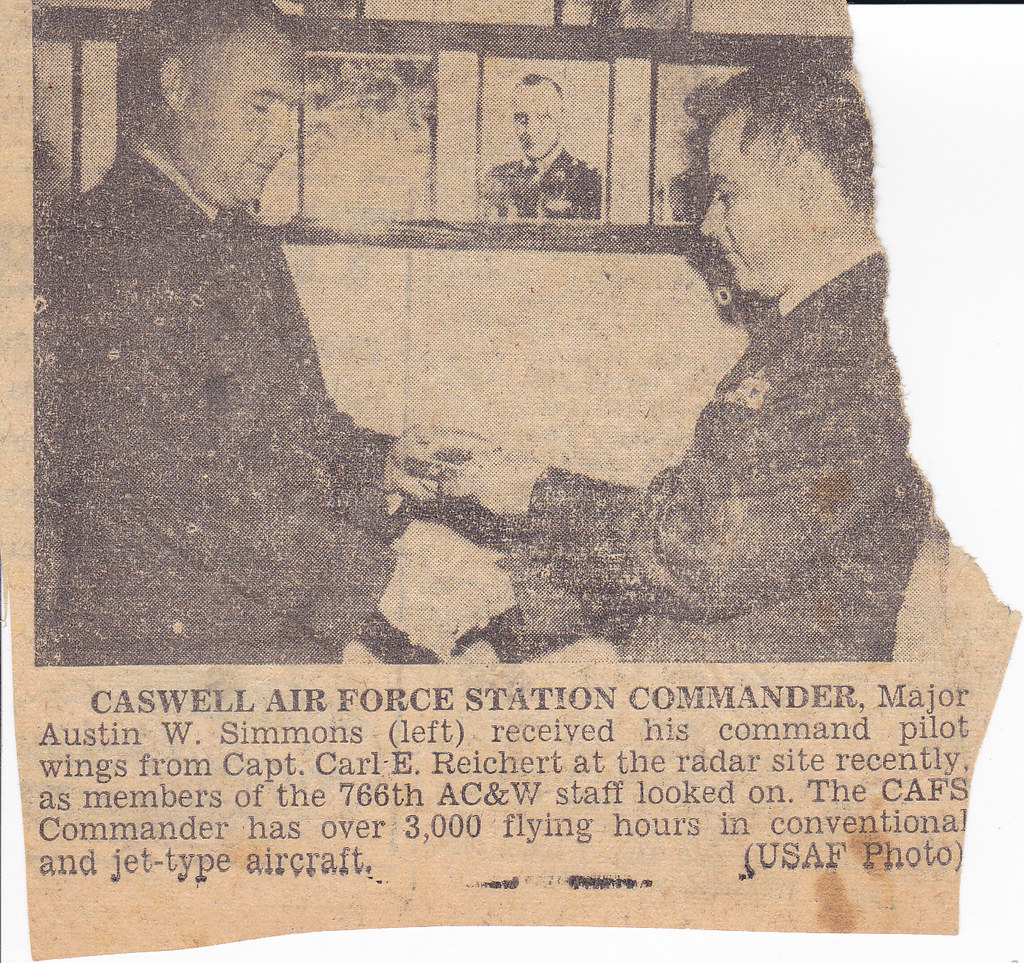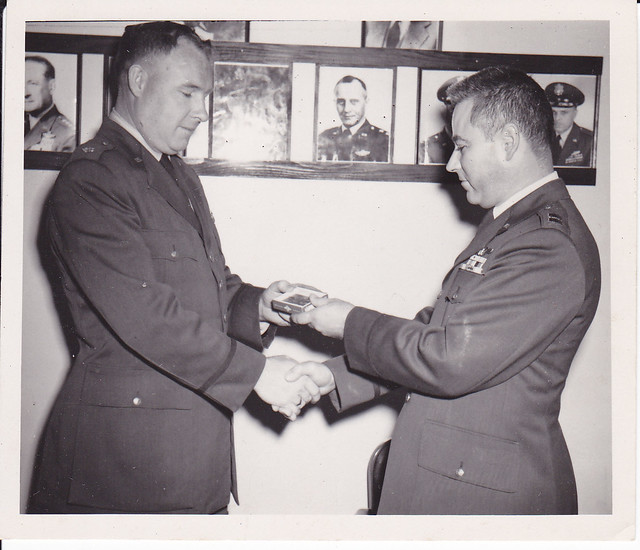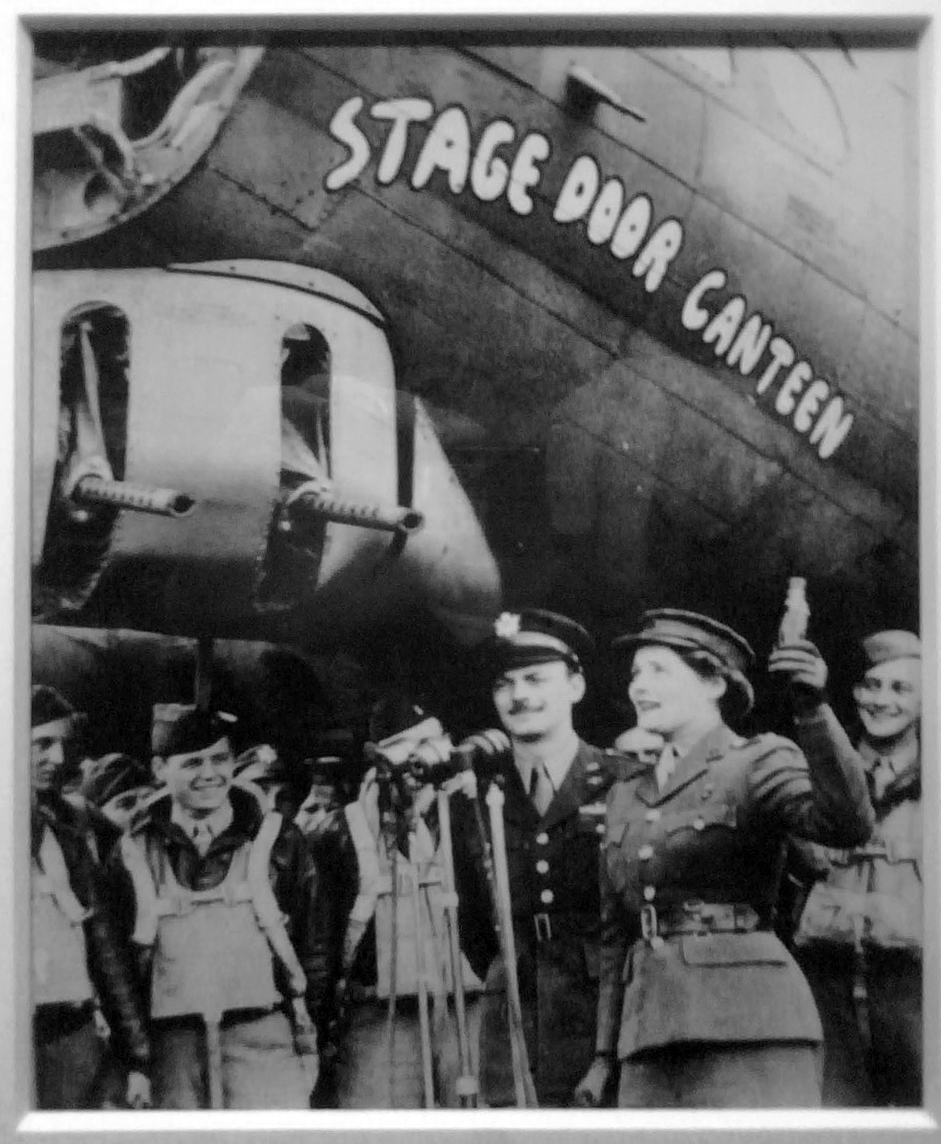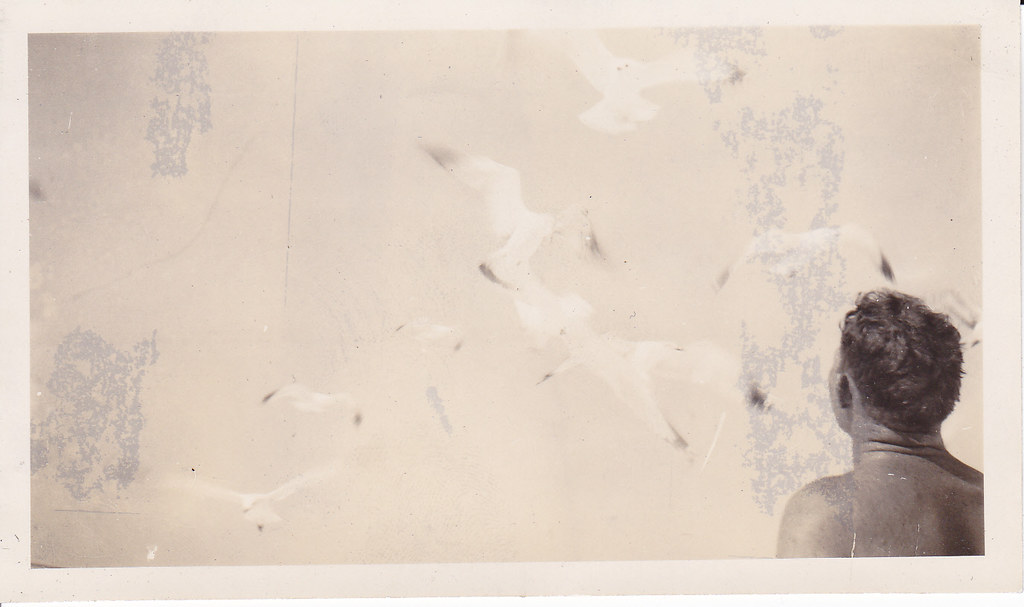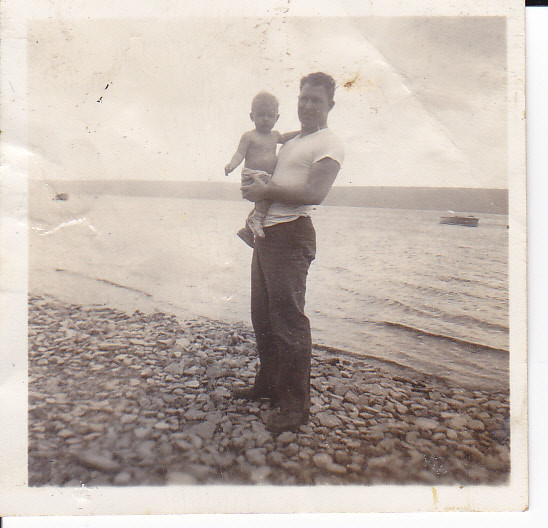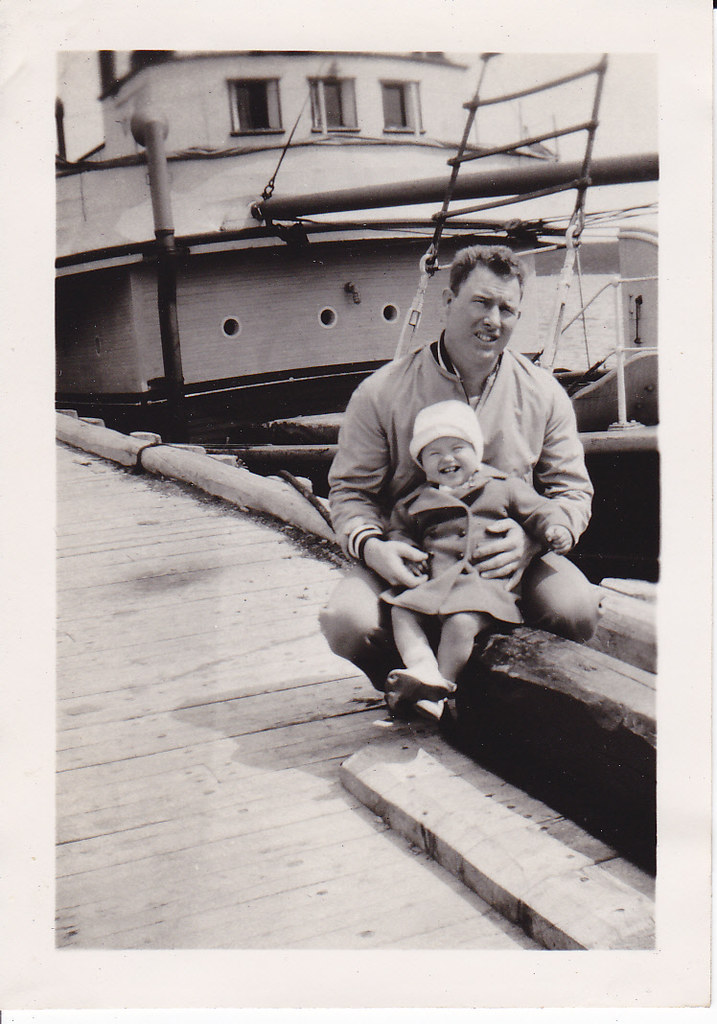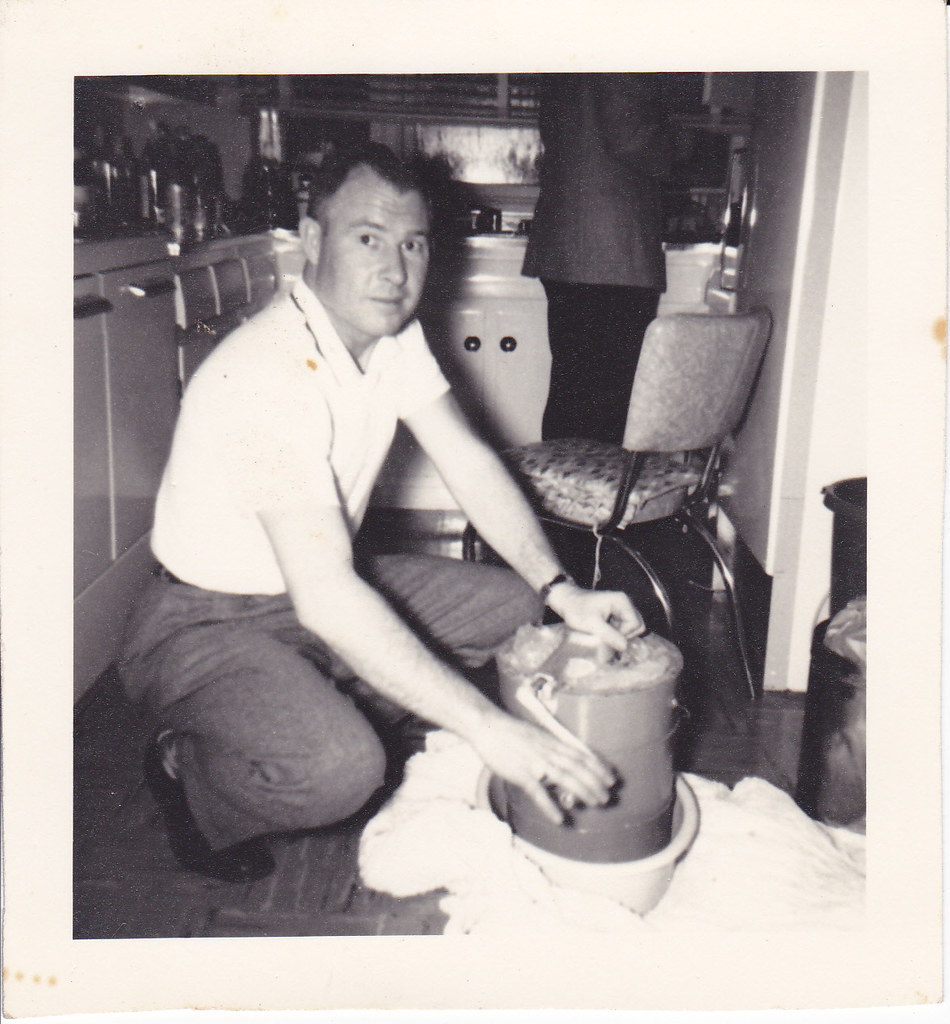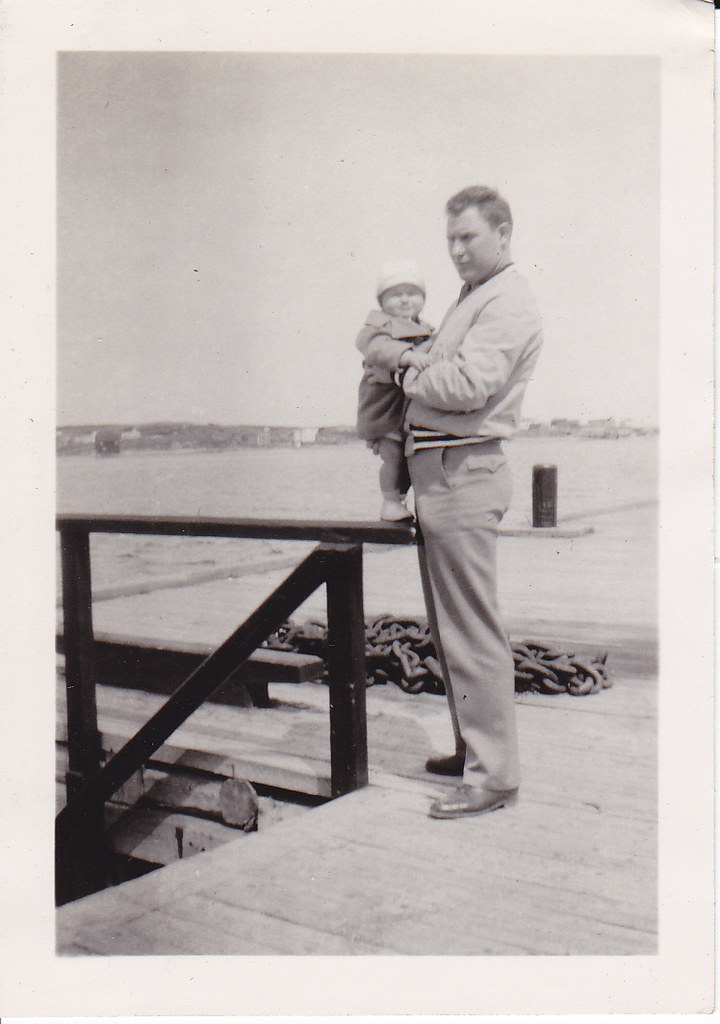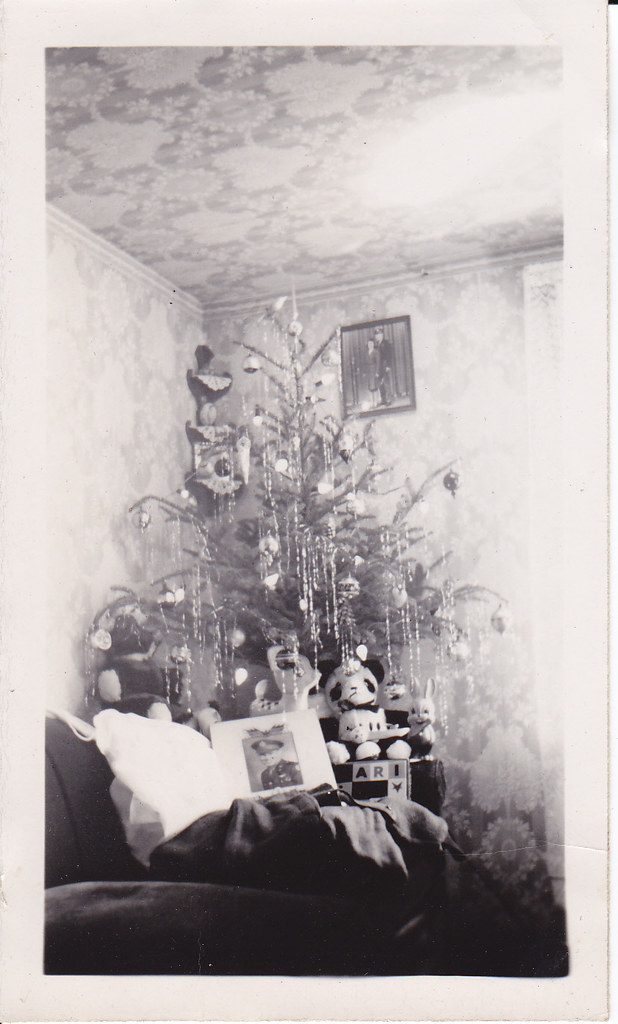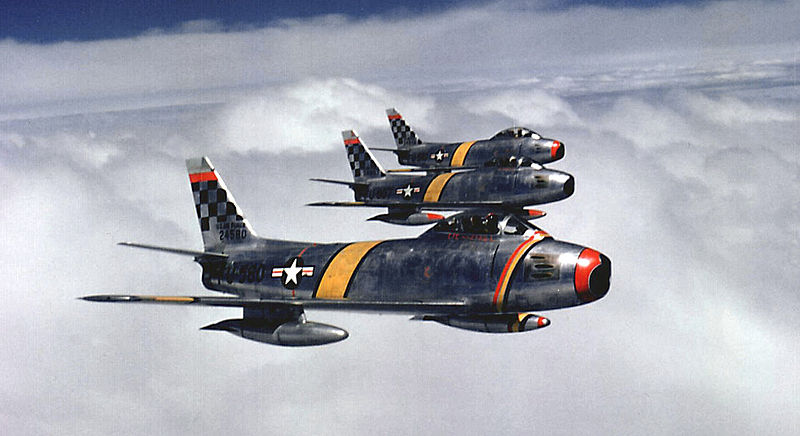It's been a while since I've posted up here, having moved on to some other projects.
Besides a couple of things I hung onto for myself, I UPS'd all 29 pounds worth of medals, books, documents, photos, patches.... back home to PA right before Christmas.
Back around 1981-82, I was given all of Austin's medals along with The Mighty Men of the 381st which was dedicated to him on the inside cover by Chaplin Brown along with a 2 page, typed letter that somehow mananged never to get lost. Being the eldest of his grandchildren, I somehow managed to realize what it was I had in my care and didn't seem to lose anything.
Anyway, everything is now in care of my cousin Dillan, who is about the same age I was when Austin, our grandfather, handed over that heavy ziplock bag full of medals to me.
Hopefully everything will last another couple of generations and it's back home where everyone can see and touch everything that I've had stowed away in a shoe box for so many years.
Saturday, January 15, 2011
Thursday, October 7, 2010
Medals and Distinction
Below is a list of medals, awards, etc. that Austin received. At this point I can only assume this is not a complete list but fairly close. The majority of these medals were given to me back in the early 1980's and have not been seen by anyone except myself, and my father until just recently. They were kept in the plastic bag along with the written description he provided at the time within a box inside a box. I think that throughout my childhood and later on I only handled these maybe a total of five times. It wasn't until earlier this year that I put them in a temporary display until a permanent home can be made for them.
The tragedity with all of this also comes at the loss of a number of items I can only vaguely recall around the same time I was given these medals. While living in Chicago our family drove back to Ford City, PA for a visit and Austin had given me a large bag full of patches and other items I only saw briefly. Before leaving he secured the suitcase they were in to the top of our car and we set off home. Somewhere along the Interstate our luggage fell off the roof and everything was lost forever. To my knowledge, this is all that remains as Mary mentioned that his uniforms succumbed to moths a number of years back.
Note: the eagle and crest in the upper left hand corner was the center piece for the caps pilots wore. In the lower right hand corner, I believe this is the piece Mary wore as a broach in their wedding photo. In the photo it shows a gold piece very similar to this, but as color photos were rather new at the time the color may have been off in the actual wedding photo. Also, I did not include here all of the written Commendations he received for action during WW2. He received a few for various reasons during certain bombing runs on Germany for valor, leadership, etc...
-Awarded Additional Oak Leaf Cluster December 15, 1944
-Awarded Additional Oak Leaf Cluster February 26, 1945
The Air Medal was awarded to personnel who, while serving in any capacity in or with the Armed Forces of the United States, shall have distinguished himself/herself by meritorious achievement while participating in aerial flight. Awards may be made to recognize single acts of merit or heroism, or for meritorious service.
American Campaign Medal - WW II
Awarded to service members performing either one year of consecutive duty between December 7, 1941 to March 2, 1946 within the continental borders of the United States, or performing 30 days consecutive or 60 non-consecutive days of duty outside the borders of the United States but within the American Theater of Operations. The American Theater was defined as the entirety of the United States to include most of the Atlantic Ocean, a portion of Alaska, and a small portion of the Pacific bordering California and Baja California. Service stars were authorized to any service member who was engaged in actual combat with Axis forces within the American theater. This primarily applied to those members of the military which had engaged in anti-U-Boat patrols in the Atlantic.
Armed Forces Reserve Medal - Air Force Version
Awarded November 17, 1954
6146th Air Force Advisory Group (ROK AF)-San Francisco, CA
Commander: Herbert L Daniels, Major.
Awarded to service members completing a total of ten years service as a member of a Reserve or National Guard component of the United States military. This service may be cumulative, provided that the combined ten years of service was performed over a period of twelve consecutive years. Voluntary recalls to active duty are not counted within the ten years of service nor is service within the inactive reserves (IRR).
The Armed Forces Reserve Medal is also awarded to any member of the Reserve of National Guard who is mobilized to an active duty status. In such cases, the ten year period criterion is waived and the Armed Forces Reserve Medal is presented regardless of time in service. The Mobilization device is awarded as an attachment to the Armed Forces Reserve Medal in all such cases of mobilization to active duty.
The Armed Forces Reserve Medal is a service wide decoration for all branches of the military and is presented to both officers and enlisted personnel.
Distinguished Flying Cross Medal
Awarded-April 9, 1945, received medal September 26, 1945
Awarded to any officer or enlisted member of the United States armed forces who distinguishes himself or herself in combat in support of operations by "heroism or extraordinary achievement while participating in an aerial flight, subsequent to November 11, 1918." The decoration may also be given for an act performed prior to that date when the individual has been recommended for, but has not received the Medal of Honor, Distinguished Service Cross, Navy Cross, or Distinguished Service Medal. During wartime, members of the Armed Forces of friendly foreign nations serving with the United States are eligible for the award. It is also given to those who display heroism while working as instructors or students at flying schools.
National Defense Service Medal
Awarded to anyone who serves on active duty in the United States military during a designated time period. In the fifty years since the creation of the National Defense Service Medal, it has been authorized for the following time periods; June 27, 1950 to July 27, 1954 for service during the Korean War; January 1, 1961 to August 14, 1974 for service during the Vietnam War; August 2, 1990 to November 30, 1995 for service during the Gulf War; September 11, 2001 to a date yet-to-be-determined for service during the War on Terrorism. For service in the Gulf War and War on Terrorism, it is also authorized for members of the military reserve provided they are a “military reservist in good standing.” The National Defense Service Medal is further authorized to students at the service academies, but is not granted to discharged or retired veterans who did not serve in one of the above time periods. The decoration is also not authorized to members of the inactive reserve. The award was intended to be a “blanket campaign medal” issued to any member of the United States military who served in a designated time period of which a “national emergency” had been declared. As of 2005, it is the oldest service medal which is still issued to the active military.
World War II (WWII) Victory Medal
Awarded to any member of the United States military who served on active duty, or as a reservist, between December 7, 1941 and December 31, 1946. The World War II Victory Medal was first issued as a ribbon, and was referred to simply as the “Victory Ribbon.” By 1946, a full medal had been established which was referred to as the World War II Victory Medal. There is no minimum service time limit for the issuance of the World War II Victory Medal, and the National Personnel Records Center has reported some cases of service members receiving the award for simply a few days of service. As the Second World War ended in August 1945, there are also cases of service members, who had enlisted in 1946, receiving the decoration without having been a veteran of World War II.
Chungmoo Distinguished Military Service Medal (image below)
Received Sept 29, 1955
Issued by Won Yil Sohn, Minister of National Defense, Republic of Korea
Translation:
....To Major Austin W. Simmons, 6146th Flying Training Group, USAF
Major Austin W. Simmons, United States Air Force distinguished himself by exceptionally meritorious service as communication advisor to the Republic of Korea Air Force from 1 November 1954 to 20 September 1955. His enthusiastic and determined effort in formulating and monitoring the overall communication operation and expansion of communication organization of the Republic of Korea Air Force has contributed to the successfull accomplishment of the mission, especially he has yielded great benefit to the Republic of Korea Air Force by initiating the communication training for VHF/FM and Carrier Mechanics at Technical Training School, Fifth Communication Group, Fifth Air Force since 4 January 1955. Major Simmons displayed his meritorious performance of duty in the Radar Training of ROK Air Force personnel at 502nd Tactical Control Group, Fifth Air Force since 17 January 1955. When the ROK Air Force headquarters moved from Taegu to k-16 maintenance of all Telephone line and communication equipment were manipulated successfully by his precise planning and persistent efforts. His outstanding devotion to duty reflected great credit upon himself, the Fifth Air Force and the United States Air Force.
Ribbons And Awards
Air Force Longevity Service Award included bronze oak leaf cluster
Awarded to U.S. Air Force personnel completing four years of Active, Reserve, or Air National Guard service. For those members of the Reserve and National Guard, service must have been in a drilling status with regular attending of weekend drills and annual training. The decoration is awarded to both officers and enlisted personnel, in contrast to service stripes which are only provided to enlisted members of the military. The award was first issued in 1957 by order of General Thomas D. White, Air Force Chief of Staff. It was primarily created as an Air Force equivalent to the service stripes used by other branches of the United States military to denote years of military service. Additional awards of the Air Force Longevity Service Award are denoted by oak leaf clusters. The award is retroactive to the founding of the Air Force in 1947.
European - African - Middle Eastern Campaign Medal Ribbon included triple bronze star cluster
Awarded for any service performed between December 7, 1941 and March 2, 1946 provided such service was performed in the geographical theater areas of Europe, North Africa, or the Middle East. For those service members who participated in multiple battle campaigns, service stars are authorized to the decoration with the arrowhead device awarded for any airborne or amphibious operations performed. The Fleet Marine Force combat operation insignia is also authorized for certain sailors. The following campaigns are recognized by service stars to the European-African-Middle Eastern Campaign Medal: Egypt-Libya: 11 Jun 42 - 12 Feb 43; Air Offensive, Europe: 4 Jul 42 - 5 Jun 44; Algeria-French Morocco: 8-11 Nov 42; Tunisia: 12 Nov 42 - 13 May 43; Sicily: 14 May 43 - 17 Aug 43; Naples-Foggia: 18 Aug 43 - 21 Jan 44; Anzio: 22 Jan 44 - 24 May 44; Rome-Arno: 22 Jan 44 - 9 Sep 44; Normandy: 6 Jun 44 - 24 Jul 44; Northern France: 25 Jul 44 - 14 Sep 44; Southern France: 15 Aug 44 - 14 Sep 44; Northern Apennines: 10 Sep 44 - 4 Apr 45; Rhineland: 15 Sep 44 - 21 Mar 45; Ardennes-Alsace: 16 Dec 44 - 25 Jan 45; Central Europe: 22 Mar 45 - 11 May 45; Po Valley: 5 Apr 45 - 8 May 45. For those service members who did not participate in a designated battle campaign, the following "blanket campaigns" are authorized to the European-African-Middle Eastern Campaign Medal, denoted by service stars: Antisubmarine: 7 Dec 41 - 2 Sep 45; Ground Combat: 7 Dec 41 - 2 Sep 45; Air Combat: 7 Dec 41 - 2 Sep 45.
Air Force Good Conduct Medal Ribbon
Awarded to any enlisted member of the United States military (except U.S. Air Force personnel after 2006) who completes three consecutive years of "honorable and faithful service." Such service implies that a standard enlistment was completed without any non-judicial punishments, disciplinary infractions, or court martial offenses. If a service member commits an offense, the three-year mark "resets" and a service member must perform an additional three years of discipline free service before the Good Conduct may be authorized. The Air Force Good Conduct Medal which was authorized by Congress on July 6, 1960, but not created until June 1, 1963. Between 1947 and 1963, Air Force personnel were issued the Army Good Conduct Medal. For those serving both before and after 1963, both the Army and Air Force Good Conduct Medals could be worn simultaneously on an Air Force uniform. The 97th Air Force Uniform Board met in October 2005 and made the decision to discontinue the medal with the rationale that good conduct of Airmen is the expected standard, not an exceptional occurrence worthy of recognition. On 8 February 2006, the Board announced that effective immediately new medals will no longer be issued, but previously awarded medals that are a matter of record may still be worn. Additional decorations of the Air Force Good Conduct Medal are denoted by oak leaf clusters.
Triple Bronze Star
A service star, also referred to as a battle star, campaign star, or engagement star, is an attachment to a military decoration which denotes participation in military campaigns or multiple bestowals of the same award. Service stars are typically issued for campaign medals, service medals, ribbon awards, and certain military badges. Service stars are different from award stars, which are issued for multiple awards of meritorious and combat decorations. The United States military issues bronze and silver and gold service stars, with a silver service star issued “in lieu” of five bronze. For instance, six campaigns, served on a campaign medal, would be annotated by one silver and one bronze service star. In some situations, service stars are only issued after the second award of a decoration. For instance, three awards of a Sea Service Ribbon would be annotated by the ribbon with two bronze service stars. The United States Army also occasionally issues award numerals, instead of service stars, to denote multiple awards of certain ribbon decorations. In addition to award numerals, the United States Army uses the same Gold award star that is worn on many Navy, Marine Corps and Coast Guard decorations to denote the tenth and final award of the Army Sea Duty Ribbon. Service stars issued for actions in which a United States Navy vessel participated are also placed on campaign streamers, which are affixed to the U.S. Navy flag. The regulations for this originated in 1942, which defined naval campaign areas and designated engagements. Participation in such engagements, by ships and by individuals, was then denoted by service stars. The United States Army followed a very similar practice with ground campaigns and battle engagements. A common point of confusion is to confuse bronze and silver service stars with the Silver Star and Bronze Star Medal. The main difference between the two is that the Bronze and Silver Star Medals are individual decorations while service stars are worn on awards and are not individual decorations or medals.
The tragedity with all of this also comes at the loss of a number of items I can only vaguely recall around the same time I was given these medals. While living in Chicago our family drove back to Ford City, PA for a visit and Austin had given me a large bag full of patches and other items I only saw briefly. Before leaving he secured the suitcase they were in to the top of our car and we set off home. Somewhere along the Interstate our luggage fell off the roof and everything was lost forever. To my knowledge, this is all that remains as Mary mentioned that his uniforms succumbed to moths a number of years back.
Note: the eagle and crest in the upper left hand corner was the center piece for the caps pilots wore. In the lower right hand corner, I believe this is the piece Mary wore as a broach in their wedding photo. In the photo it shows a gold piece very similar to this, but as color photos were rather new at the time the color may have been off in the actual wedding photo. Also, I did not include here all of the written Commendations he received for action during WW2. He received a few for various reasons during certain bombing runs on Germany for valor, leadership, etc...
Air Medal-Awarded August 2, 1944 included 4 Bronze Oak Leaf Clusters
-Awarded Oak Leaf Cluster September 2, 1944 “For meritorious achievement while participating in sustained bomber combat operations over Germany and German occupied countries…”
-Awarded Additional Oak Leaf Cluster October 2, 1944-Awarded Additional Oak Leaf Cluster December 15, 1944
-Awarded Additional Oak Leaf Cluster February 26, 1945
The Air Medal was awarded to personnel who, while serving in any capacity in or with the Armed Forces of the United States, shall have distinguished himself/herself by meritorious achievement while participating in aerial flight. Awards may be made to recognize single acts of merit or heroism, or for meritorious service.
American Campaign Medal - WW II
Awarded to service members performing either one year of consecutive duty between December 7, 1941 to March 2, 1946 within the continental borders of the United States, or performing 30 days consecutive or 60 non-consecutive days of duty outside the borders of the United States but within the American Theater of Operations. The American Theater was defined as the entirety of the United States to include most of the Atlantic Ocean, a portion of Alaska, and a small portion of the Pacific bordering California and Baja California. Service stars were authorized to any service member who was engaged in actual combat with Axis forces within the American theater. This primarily applied to those members of the military which had engaged in anti-U-Boat patrols in the Atlantic.
Armed Forces Reserve Medal - Air Force Version
Awarded November 17, 1954
6146th Air Force Advisory Group (ROK AF)-San Francisco, CA
Commander: Herbert L Daniels, Major.
Awarded to service members completing a total of ten years service as a member of a Reserve or National Guard component of the United States military. This service may be cumulative, provided that the combined ten years of service was performed over a period of twelve consecutive years. Voluntary recalls to active duty are not counted within the ten years of service nor is service within the inactive reserves (IRR).
The Armed Forces Reserve Medal is also awarded to any member of the Reserve of National Guard who is mobilized to an active duty status. In such cases, the ten year period criterion is waived and the Armed Forces Reserve Medal is presented regardless of time in service. The Mobilization device is awarded as an attachment to the Armed Forces Reserve Medal in all such cases of mobilization to active duty.
The Armed Forces Reserve Medal is a service wide decoration for all branches of the military and is presented to both officers and enlisted personnel.
Distinguished Flying Cross Medal
Awarded-April 9, 1945, received medal September 26, 1945
Awarded to any officer or enlisted member of the United States armed forces who distinguishes himself or herself in combat in support of operations by "heroism or extraordinary achievement while participating in an aerial flight, subsequent to November 11, 1918." The decoration may also be given for an act performed prior to that date when the individual has been recommended for, but has not received the Medal of Honor, Distinguished Service Cross, Navy Cross, or Distinguished Service Medal. During wartime, members of the Armed Forces of friendly foreign nations serving with the United States are eligible for the award. It is also given to those who display heroism while working as instructors or students at flying schools.
National Defense Service Medal
Awarded to anyone who serves on active duty in the United States military during a designated time period. In the fifty years since the creation of the National Defense Service Medal, it has been authorized for the following time periods; June 27, 1950 to July 27, 1954 for service during the Korean War; January 1, 1961 to August 14, 1974 for service during the Vietnam War; August 2, 1990 to November 30, 1995 for service during the Gulf War; September 11, 2001 to a date yet-to-be-determined for service during the War on Terrorism. For service in the Gulf War and War on Terrorism, it is also authorized for members of the military reserve provided they are a “military reservist in good standing.” The National Defense Service Medal is further authorized to students at the service academies, but is not granted to discharged or retired veterans who did not serve in one of the above time periods. The decoration is also not authorized to members of the inactive reserve. The award was intended to be a “blanket campaign medal” issued to any member of the United States military who served in a designated time period of which a “national emergency” had been declared. As of 2005, it is the oldest service medal which is still issued to the active military.
World War II (WWII) Victory Medal
Awarded to any member of the United States military who served on active duty, or as a reservist, between December 7, 1941 and December 31, 1946. The World War II Victory Medal was first issued as a ribbon, and was referred to simply as the “Victory Ribbon.” By 1946, a full medal had been established which was referred to as the World War II Victory Medal. There is no minimum service time limit for the issuance of the World War II Victory Medal, and the National Personnel Records Center has reported some cases of service members receiving the award for simply a few days of service. As the Second World War ended in August 1945, there are also cases of service members, who had enlisted in 1946, receiving the decoration without having been a veteran of World War II.
Chungmoo Distinguished Military Service Medal (image below)
Received Sept 29, 1955
Issued by Won Yil Sohn, Minister of National Defense, Republic of Korea
Translation:
....To Major Austin W. Simmons, 6146th Flying Training Group, USAF
Major Austin W. Simmons, United States Air Force distinguished himself by exceptionally meritorious service as communication advisor to the Republic of Korea Air Force from 1 November 1954 to 20 September 1955. His enthusiastic and determined effort in formulating and monitoring the overall communication operation and expansion of communication organization of the Republic of Korea Air Force has contributed to the successfull accomplishment of the mission, especially he has yielded great benefit to the Republic of Korea Air Force by initiating the communication training for VHF/FM and Carrier Mechanics at Technical Training School, Fifth Communication Group, Fifth Air Force since 4 January 1955. Major Simmons displayed his meritorious performance of duty in the Radar Training of ROK Air Force personnel at 502nd Tactical Control Group, Fifth Air Force since 17 January 1955. When the ROK Air Force headquarters moved from Taegu to k-16 maintenance of all Telephone line and communication equipment were manipulated successfully by his precise planning and persistent efforts. His outstanding devotion to duty reflected great credit upon himself, the Fifth Air Force and the United States Air Force.
Ribbons And Awards
Air Force Longevity Service Award included bronze oak leaf cluster
Awarded to U.S. Air Force personnel completing four years of Active, Reserve, or Air National Guard service. For those members of the Reserve and National Guard, service must have been in a drilling status with regular attending of weekend drills and annual training. The decoration is awarded to both officers and enlisted personnel, in contrast to service stripes which are only provided to enlisted members of the military. The award was first issued in 1957 by order of General Thomas D. White, Air Force Chief of Staff. It was primarily created as an Air Force equivalent to the service stripes used by other branches of the United States military to denote years of military service. Additional awards of the Air Force Longevity Service Award are denoted by oak leaf clusters. The award is retroactive to the founding of the Air Force in 1947.
European - African - Middle Eastern Campaign Medal Ribbon included triple bronze star cluster
Awarded for any service performed between December 7, 1941 and March 2, 1946 provided such service was performed in the geographical theater areas of Europe, North Africa, or the Middle East. For those service members who participated in multiple battle campaigns, service stars are authorized to the decoration with the arrowhead device awarded for any airborne or amphibious operations performed. The Fleet Marine Force combat operation insignia is also authorized for certain sailors. The following campaigns are recognized by service stars to the European-African-Middle Eastern Campaign Medal: Egypt-Libya: 11 Jun 42 - 12 Feb 43; Air Offensive, Europe: 4 Jul 42 - 5 Jun 44; Algeria-French Morocco: 8-11 Nov 42; Tunisia: 12 Nov 42 - 13 May 43; Sicily: 14 May 43 - 17 Aug 43; Naples-Foggia: 18 Aug 43 - 21 Jan 44; Anzio: 22 Jan 44 - 24 May 44; Rome-Arno: 22 Jan 44 - 9 Sep 44; Normandy: 6 Jun 44 - 24 Jul 44; Northern France: 25 Jul 44 - 14 Sep 44; Southern France: 15 Aug 44 - 14 Sep 44; Northern Apennines: 10 Sep 44 - 4 Apr 45; Rhineland: 15 Sep 44 - 21 Mar 45; Ardennes-Alsace: 16 Dec 44 - 25 Jan 45; Central Europe: 22 Mar 45 - 11 May 45; Po Valley: 5 Apr 45 - 8 May 45. For those service members who did not participate in a designated battle campaign, the following "blanket campaigns" are authorized to the European-African-Middle Eastern Campaign Medal, denoted by service stars: Antisubmarine: 7 Dec 41 - 2 Sep 45; Ground Combat: 7 Dec 41 - 2 Sep 45; Air Combat: 7 Dec 41 - 2 Sep 45.
Air Force Good Conduct Medal Ribbon
Awarded to any enlisted member of the United States military (except U.S. Air Force personnel after 2006) who completes three consecutive years of "honorable and faithful service." Such service implies that a standard enlistment was completed without any non-judicial punishments, disciplinary infractions, or court martial offenses. If a service member commits an offense, the three-year mark "resets" and a service member must perform an additional three years of discipline free service before the Good Conduct may be authorized. The Air Force Good Conduct Medal which was authorized by Congress on July 6, 1960, but not created until June 1, 1963. Between 1947 and 1963, Air Force personnel were issued the Army Good Conduct Medal. For those serving both before and after 1963, both the Army and Air Force Good Conduct Medals could be worn simultaneously on an Air Force uniform. The 97th Air Force Uniform Board met in October 2005 and made the decision to discontinue the medal with the rationale that good conduct of Airmen is the expected standard, not an exceptional occurrence worthy of recognition. On 8 February 2006, the Board announced that effective immediately new medals will no longer be issued, but previously awarded medals that are a matter of record may still be worn. Additional decorations of the Air Force Good Conduct Medal are denoted by oak leaf clusters.
Cluster definitions. These were pinned across certain ribbons.
Four Bronze Oak Leaf Cluster
Bronze and Silver Oak Leaf Clusters are common devices placed on many United States military awards and decorations signifying multiple bestowals of a particular award. The number of oak leaf clusters indicates the second and subsequent awards of the decoration. One single oak leaf cluster, for example, is attached to the designated award and denotes a second award of that particular decoration. Service members do not wear more than one service ribbon on their ribbon rack even when they have received the award more than once. Instead, multiple awards are shown by attaching the oak leaves to the ribbon. One single oak leaf denotes the second award of that particular decoration. Two oak leaves denotes three awards. Four denote five awards. When the sixth award of a specific decoration is bestowed on the individual, a single “silver” bronze oak leaf is placed on the ribbon (as opposed to five bronze oak leaves). Oak leaves are most commonly employed by the U.S. Army and U.S. Air Force to denote multiple awards. The U.S. Navy, Marine Corps and Coast Guard typically employ Gold and Silver Stars to signify multiple awards. Specific use of these devices, however, vary between services.
Bronze and Silver Oak Leaf Clusters are common devices placed on many United States military awards and decorations signifying multiple bestowals of a particular award. The number of oak leaf clusters indicates the second and subsequent awards of the decoration. One single oak leaf cluster, for example, is attached to the designated award and denotes a second award of that particular decoration. Service members do not wear more than one service ribbon on their ribbon rack even when they have received the award more than once. Instead, multiple awards are shown by attaching the oak leaves to the ribbon. One single oak leaf denotes the second award of that particular decoration. Two oak leaves denotes three awards. Four denote five awards. When the sixth award of a specific decoration is bestowed on the individual, a single “silver” bronze oak leaf is placed on the ribbon (as opposed to five bronze oak leaves). Oak leaves are most commonly employed by the U.S. Army and U.S. Air Force to denote multiple awards. The U.S. Navy, Marine Corps and Coast Guard typically employ Gold and Silver Stars to signify multiple awards. Specific use of these devices, however, vary between services.
Triple Bronze Star
A service star, also referred to as a battle star, campaign star, or engagement star, is an attachment to a military decoration which denotes participation in military campaigns or multiple bestowals of the same award. Service stars are typically issued for campaign medals, service medals, ribbon awards, and certain military badges. Service stars are different from award stars, which are issued for multiple awards of meritorious and combat decorations. The United States military issues bronze and silver and gold service stars, with a silver service star issued “in lieu” of five bronze. For instance, six campaigns, served on a campaign medal, would be annotated by one silver and one bronze service star. In some situations, service stars are only issued after the second award of a decoration. For instance, three awards of a Sea Service Ribbon would be annotated by the ribbon with two bronze service stars. The United States Army also occasionally issues award numerals, instead of service stars, to denote multiple awards of certain ribbon decorations. In addition to award numerals, the United States Army uses the same Gold award star that is worn on many Navy, Marine Corps and Coast Guard decorations to denote the tenth and final award of the Army Sea Duty Ribbon. Service stars issued for actions in which a United States Navy vessel participated are also placed on campaign streamers, which are affixed to the U.S. Navy flag. The regulations for this originated in 1942, which defined naval campaign areas and designated engagements. Participation in such engagements, by ships and by individuals, was then denoted by service stars. The United States Army followed a very similar practice with ground campaigns and battle engagements. A common point of confusion is to confuse bronze and silver service stars with the Silver Star and Bronze Star Medal. The main difference between the two is that the Bronze and Silver Star Medals are individual decorations while service stars are worn on awards and are not individual decorations or medals.
Friday, October 1, 2010
Media
Below are but a handful of articles pertaining to Austin later on in his career. Rather than writing about what you can simply read in each article, I'm just posting them up in their original size to make them easier to view. Some did not have any dates associated or printed on them as well as publication names, so I can only guess as to when these were circulated.
Below is the actual photo used in the article above.
Below is the actual photo used in the article above.
Friday, August 6, 2010
Complete List of Combat B-17's Flown in WW2
Kevin Wilson of the 381st.org sent me a complete list of the planes flown by Austin during WW2. To date I've only found a couple of photos of him standing in front of The Alamo which he flew later in the war so this list along with the serial numbers of the plane along with his crew has helped tremendously. I've tried to locate as many images of the nose art and have included them below to the best of accuracy as I could.
Planes are listed in order as per his mission log.
-Wild Bill (MS-Z)42-37538 (used in 2 missions, first mission ever-he was co-pilot.)
-In Like Errol (MS-M)42-102590 (used in 2 missions, named for Errol Flynn. Plane was lost on 3/30/45.)
-Feather Merchant (MS-Y)42-37553 (the original Feather Merchant was lost on 10/8/43)
-Stage Door Canteen (MS-R)42-31990 (named by Vivien Leigh, Lawrence Olivier and Mary Churchill).
-Columbus Miss (MS-N)42-97313 (used in 2 missions)
-Me & My Gal (MS-W)42-40017 (note: this plane was salvaged and renamed twice Miasses Dragon and Assend, I was unable to locate a photo with the nose art Austin flew.)
-Hells Angel (MS-P)42-97265 (note: there were two Hells Angel's in the 381st, the other was shot down 8/17/43)
-Los Angeles City Limits (MS-U)42-107018 (used in 4 missions)
-Tomahawk Warrior (MS-X)42-97267
-Pair of Queens Gee & Bee (MS-J)42-38127 (used in 3 missions, flew once as co-pilot.)
-Dee Marie (GD-K)42-97076 (flew as group lead, plane loaned from the 534th)
-no name (PFF) (GD-J)44-8036 (loaned from the 534th)
-no name (VP-N)44-8175 (used in 2 missions, planed loaned from the 533rd)
-The Alamo (MS-L)44-8228 (used in 2 missions)
-Sunkist Special (MS-I)42-97625 (used in 2 missions)
-Crack O' Dawn (MS-S)43-38998 (loaned from the 533rd, flew as group lead)
-no name (PFF) (VP-U)44-8196
-no name (MS-N)44-8402 (used in 2 missions)
Planes are listed in order as per his mission log.
-Wild Bill (MS-Z)42-37538 (used in 2 missions, first mission ever-he was co-pilot.)
-In Like Errol (MS-M)42-102590 (used in 2 missions, named for Errol Flynn. Plane was lost on 3/30/45.)
-Feather Merchant (MS-Y)42-37553 (the original Feather Merchant was lost on 10/8/43)
-Stage Door Canteen (MS-R)42-31990 (named by Vivien Leigh, Lawrence Olivier and Mary Churchill).
-Columbus Miss (MS-N)42-97313 (used in 2 missions)
-Me & My Gal (MS-W)42-40017 (note: this plane was salvaged and renamed twice Miasses Dragon and Assend, I was unable to locate a photo with the nose art Austin flew.)
-Hells Angel (MS-P)42-97265 (note: there were two Hells Angel's in the 381st, the other was shot down 8/17/43)
-Los Angeles City Limits (MS-U)42-107018 (used in 4 missions)
-Tomahawk Warrior (MS-X)42-97267
-Pair of Queens Gee & Bee (MS-J)42-38127 (used in 3 missions, flew once as co-pilot.)
-Dee Marie (GD-K)42-97076 (flew as group lead, plane loaned from the 534th)
-no name (PFF) (GD-J)44-8036 (loaned from the 534th)
-no name (VP-N)44-8175 (used in 2 missions, planed loaned from the 533rd)
-The Alamo (MS-L)44-8228 (used in 2 missions)
-Sunkist Special (MS-I)42-97625 (used in 2 missions)
-Crack O' Dawn (MS-S)43-38998 (loaned from the 533rd, flew as group lead)
-no name (PFF) (VP-U)44-8196
-no name (MS-N)44-8402 (used in 2 missions)
Saturday, July 31, 2010
Living Life.
At some point within the past 15 years I was given a couple of photo albums with misc., childhood photos of my father that also included a number of photos of Mary Jane and Austin just living. Below are a but a handful of those photos and shows what life was like for the young couple. My guess is that most of these were taken either in Eastern Canada or the coast of Maine with the exception of the photo of Austin on the beach in FL. I can only speculate that this photo was taken when he met his crew prior to shipping off to England to fight in the war. I will also take a guess that the child in these photos is of my father and their first born child, Darl. Most of them are not identified on the back, those that are I've included what's written.
Austin at Sarasota Beach, FL. "The birds would catch every peanut that was thrown their way."
Austin at Ganden (sp?) Lake. (child really resembles Darl in photos at that age.)
Austin on Coal Boat (could also read Caal Boat?)
Austin making ice cream.
Austin on the wharf at Catalina.
Mary Jane fishing.
The photo below was not marked on the back like so many I pulled from the two albums. It shows their Christmas tree along with a photo of Austin in uniform in front and their marriage photo hanging high on the wall in the background. There are also a bunch of toys under the tree which I can only assume were for either Darl or Darl and Karen.
Tuesday, June 29, 2010
Florida 1944
About a month ago I received a correspondance from Steven Johnson who was Angus Johnson's son (passed away in 1963). After corresponding a bit we traded photos and I received the following photo's taken in Florida, 1944. This was the time when Austin met and received the crew he would command throughout their time during the war. I want to take this time to thank Steve for these photos.
The crew, Lt. Austin Simmons back row, 2nd from the left. Angus Johnson, front row kneeling in front of Austin.
Lt. Simmons and ?? at the beach in West Palm Beach, FL May 19, 1944.
Fast forward to November 2nd, 1944, Austin took a flight up to Spetchley Park near Worcester, England. It is unclear exactly the reason for this visit. However, Spetchley Park was used by the 8th Air Force after the Battle of Britain as a place for its pilots to recuperate. It is also unclear if his entire crew accompanied him on this trip or not. I would suspect they may have as Angus Johnson took this photo of the outside of the building:
Sunday, June 13, 2010
The Pilot, Instructor and Once Again, the Soldier
Major Austin W. Simmons
A little over a decade after being called to Active Duty Cpt. Austin Simmons was promoted to Major effective April 19, 1955 despite a minor setback with the rejection of his application to become an officer in the Regular Army. A month later the promotion outlined in the April 19th letter was revoked. The reason was simply a clerical error for Cpt. Simmons was promoted to Major on July 31st, 1947 by order of the President of the United States.
It has to be noted here that Austin had only a high school education and unlike so many of those officers who stayed in the ranks had no formal schooling nor was a graduate of West Point. The advantage he had was a commission during war time in which he was able to capitalize on and use to better himself and his family. This is in no way demeaning by any means, as it is thought that promotions during war time carry more prestige, honor and are more deserved. It has been documented on many occasions and relayed by those who knew him personally that he was a very bright individual but lacked that piece of paper to back him up.
The promotion in rank in July 1947 would be his last until right before his retirement in 1963 when he was promoted to Lt. Colonel and then retired. From what his wife Mary told me this did bother him a bit so much so that it is well documented that he took a number of advanced military education courses throughout his lengthy career and received many diplomas within the military education system. If you take into consideration that he was given command of a strategically important radar base in Iceland right as Vietnam and the Cold War was acceleration I would dare to speculate that his superior officers saw in Austin an extremely intelligent and capable officer, yet had their hands tied when it came to promoting an individual without the backup of a college degree. Haven taken that into consideration I wonder what course his career would have taken him had he obtained a degree.
Despite being a Major and having already proven himself to be a skilled B-17 pilot during combat, Austin still pursued the life of a pilot and on June 24, 1955 he officially became rated as a Senior Pilot.
Two years later on April 3, 1957 he was appointed as an Instructor and a Test Pilot for the B-25 Mitchell while stationed at the 766th AC&WRON in Maine. The twin engine B-25 medium bomber was much smaller than the four engine B-17 that launched his career that became famous in 1942 during the Doolittle Raid on mainland Japan.
B-25 Mitchell
It is important to note and I will try and delve into this a bit further as more substantial documents surface to back this up, but while serving towards the end of the Korean War Major Simmons was again called upon to fly combat missions. This time it was in what he called 'kiddy cars', comparing the flight characteristics of the B-17 to his new weapon, the F-86 Sabre. Rather than lengthy bomb runs his target was the Russian MiG-15's against whom he would give chase until his fuel supply or national borders would force him to turn and call off the fight. When he spoke about this in 2004 he recalled that at the time the MiG pilots wanted nothing to do with the American Sabre's and would always turn and flee. He did get close enough to fire his weapons but was not credited with any kills. Apparently the Air Force lacked enough experienced pilots and were losing jets and pilots to rooky mistakes. Major Simmons flew each mission with two 'wingmen' who were there to watch and learn from the more experienced pilot. Often as he recalls they would land with a 'dead stick' meaning that they had run out of fuel and had to mountain hop their way back to base catching the airflows off the mountain ranges to keep their warbirds in flight.
F-86 Sabre's in formation over Korea, circa 1954.
Towards the end of his career he was still learning new aircraft and on July 1, 1961 he was designated as Aircraft Commander in R4D type aircraft. The R4D or Douglas C-47 Skytrain, commonly known as Dakota was used primarily as a military transport plane during WW2 and throughout the 1950's.
C-47
Military Education Courses:
Dec 9, 1949: Military Management, Great Falls AFB, Great Falls, MT (Note: Spelled his name ‘Auston’)
Mar 17, 1951: Electronics Officers Airborne Course, Keesler AFB, MS
Feb 23, 1954: Advanced Communications Electronics Officer Course, Keesler AFB, MS
July 1, 1954: Officers Leadership, Air Training Command, Mather AFB, California
March 1, 1957: Interceptor Controller, Air Training Command, Tyndall AFB, Florida
Sept 17, 1957: Military Affairs Course, Air University Extension Course Institute
Dec 6, 1957: Air Defense Command Controller Proficiency Training Course, 4750th Air Defense Group (WPNS), Yuma, AZ
Jan 24, 1958: SAGE Familiarization Course XX1616-3, SAGE Technical Training Sqdrn, 3380th Technical Training Grp, Waltham, MA
Mar 12, 1959: Command And Staff School Course No. 3, Extension Course Institute, USAF
June 10, 1960: Graduated Command And Staff College at Maxwell AFB, Alabama, Air University
June 19, 1961: Fund Prin Guided Missiles, Extension Course Institute, USAF
Jan 8, 1962: Government Contract Course #7801 at Gunter AFB, Alabama, Extension Course Institute, Air University.
June 15, 1962: ‘The Economics of National Security’ from the Industrial College Of The Armed Forces, scoring in the upper 25 percent of graduates.
And on June 10, 1960 Mary J. Simmons received a Distaff Diploma from the Air University ‘for having cooperated with Command and Staff College and withstanding the onslaught of Demanding Air Force Requirements, And In General Being A Major Influence In The Satisfactory Completion Of The Resident Course By Her Husband…’
Labels:
B-25 Mitchell,
C-47,
F-86 Sabre,
Major Austin W. Simmons
Subscribe to:
Posts (Atom)
